Abstract
The MS-2 system (Abbott Diagnostics, Division of Abbott Laboratories, Dallas, Tex.) is an automated system capable of rapid antimicrobial susceptibility testing. However, the short incubation periods used by the device may adversely affect its ability to detect slowly growing resistant organisms. Shortly after the introduction of the MS-2 system into the University of Mississippi Medical Center clinical microbiology laboratory, we noted discrepancies between the MS-2 and the disk diffusion susceptibility reports when methicillin-resistant Staphylococcus aureus isolates were tested. Subsequently, we determined the susceptibilities of 75 such isolates by the MS-2 and Kirby-Bauer disk diffusion methods and measured the minimum inhibitory concentrations of methicillin, oxacillin, and cephalothin for 33 of the 75 isolates by standardized agar dilution techniques. There was only 47% overall agreement between the MS-2 and disk diffusion methods when methicillin was tested and 15% agreement when cephalothin was the test drug. There was 93% or more overall agreement between the two methods when other antimicrobial agents were tested. The minimum inhibitory concentration of methicillin was greater than or equal to 16 micrograms/ml for all 33 isolates evaluated by the agar dilution method. A comparison of the MS-2 and agar dilution results revealed an overall agreement of 49% when the susceptibilities to methicillin were determined. The MS-2 system reported that multiple methicillin-resistant S. aureus isolates obtained from a single patient were either resistant, intermediate, or sensitive to methicillin. Inconsistent results were also obtained when a single isolate was tested simultaneously in 10 cuvette cartridges. We conclude that the MS-2 system does not reliably detect methicillin and cephalothin resistance among S. aureus.
Full text
PDF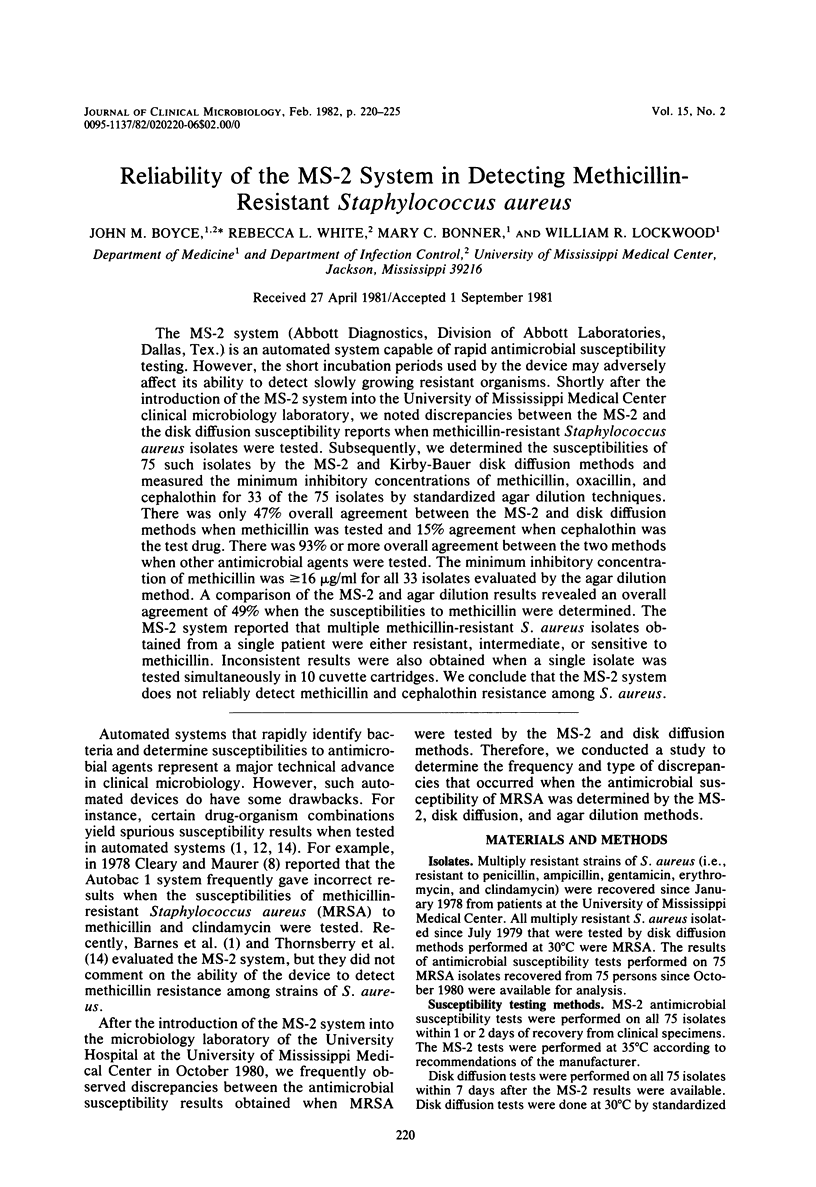
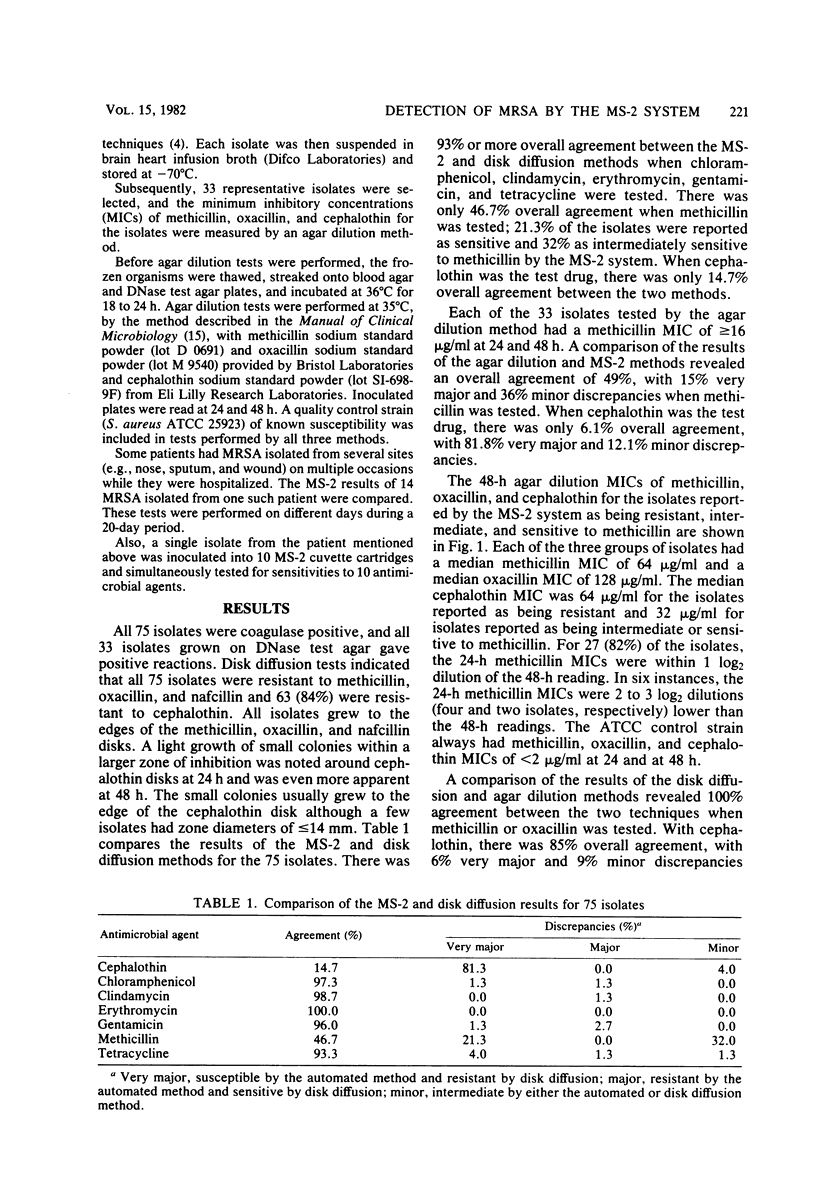
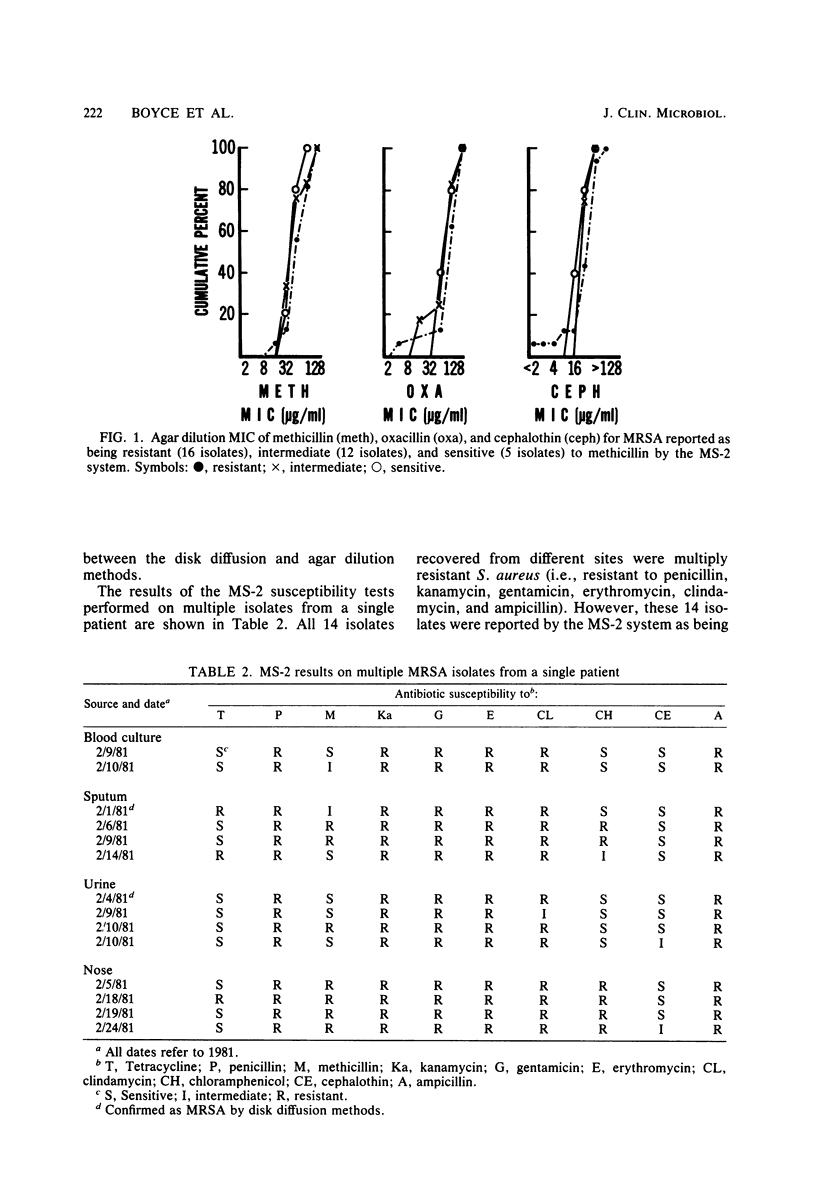
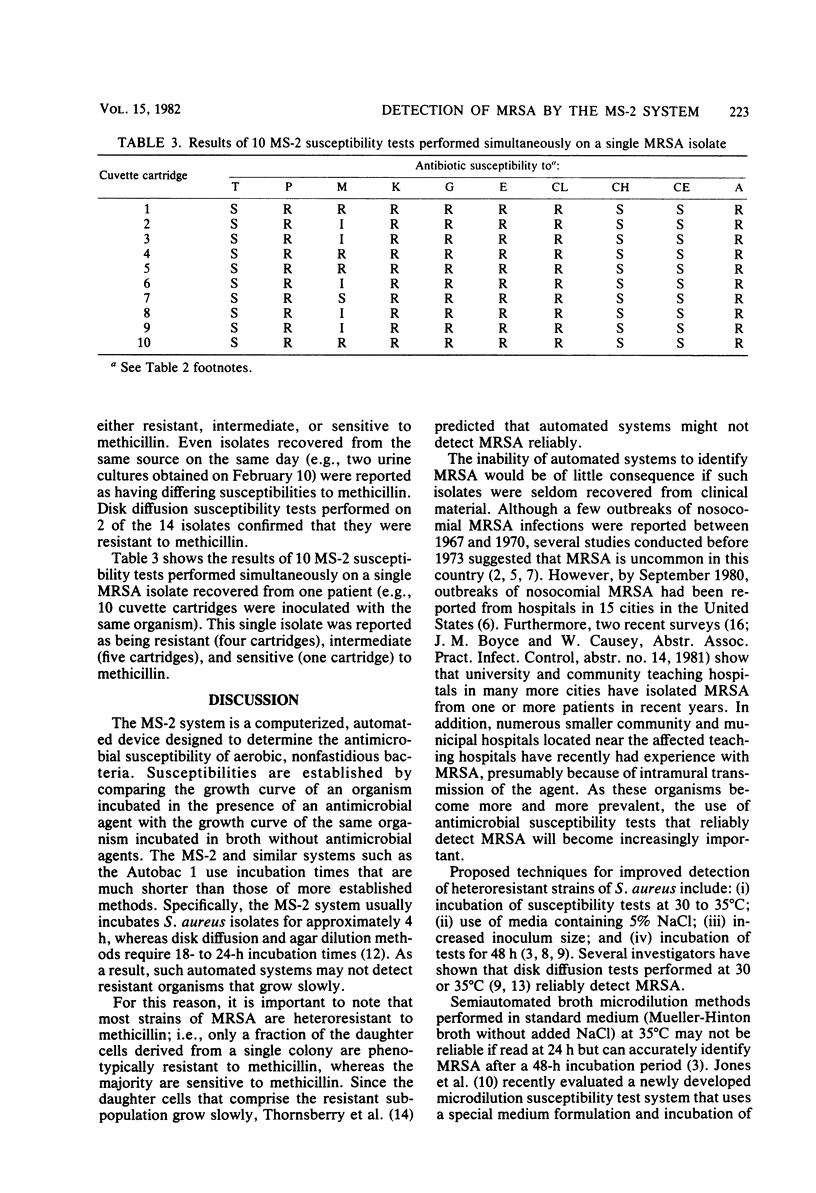
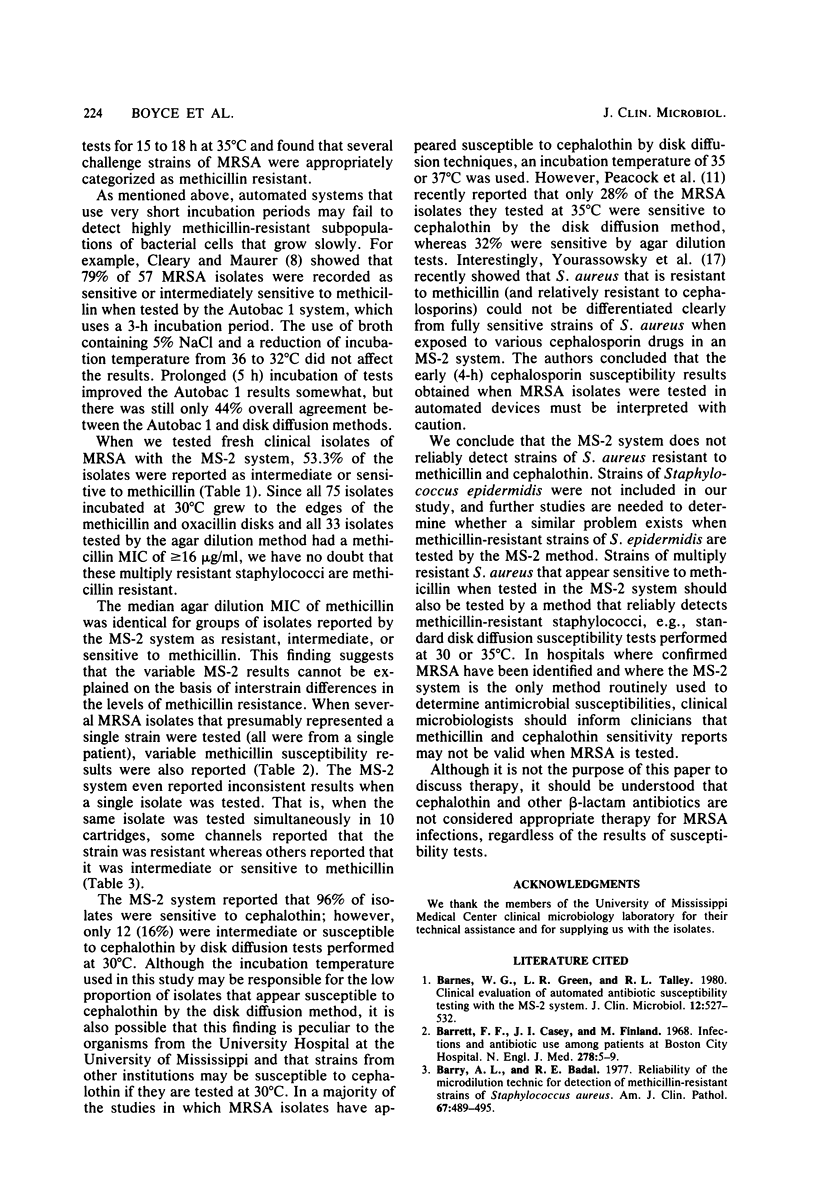
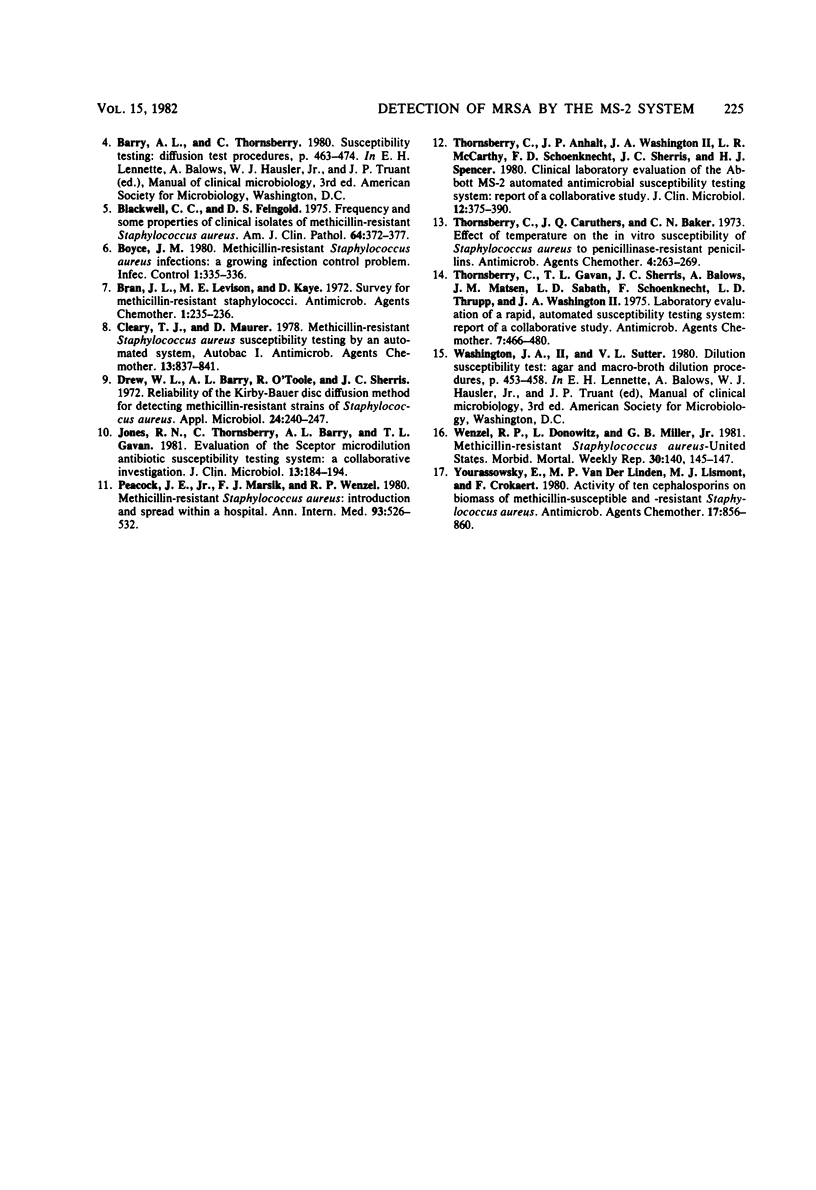
Selected References
These references are in PubMed. This may not be the complete list of references from this article.
- Barnes W. G., Green L. R., Talley R. L. Clinical evaluation of automated antibiotic susceptibility testing with the MS-2 system. J Clin Microbiol. 1980 Oct;12(4):527–532. doi: 10.1128/jcm.12.4.527-532.1980. [DOI] [PMC free article] [PubMed] [Google Scholar]
- Barrett F. F., Casey J. I., Finland M. Infections and antibiotic use among patients at Boston City Hospital, February, 1967. N Engl J Med. 1968 Jan 4;278(1):5–9. doi: 10.1056/NEJM196801042780102. [DOI] [PubMed] [Google Scholar]
- Barry A. L., Badal R. E. Reliability of the microdilution technic for detection of methicillin-resistant strains of staphylococcus aureus. Am J Clin Pathol. 1977 May;67(5):489–495. doi: 10.1093/ajcp/67.5.489. [DOI] [PubMed] [Google Scholar]
- Blackwell C. C., Feingold D. S. Frequency and some properties of clinical isolates of methicillin-resistant Staphylococcus aureus. Am J Clin Pathol. 1975 Sep;64(3):372–377. doi: 10.1093/ajcp/64.3.372. [DOI] [PubMed] [Google Scholar]
- Bran J. L., Levison M. E., Kaye D. Survey for methicillin-resistant staphylococci. Antimicrob Agents Chemother. 1972 Mar;1(3):235–236. doi: 10.1128/aac.1.3.235. [DOI] [PMC free article] [PubMed] [Google Scholar]
- Drew W. L., Barry A. L., O'Toole R., Sherris J. C. Reliability of the Kirby-Bauer disc diffusion method for detecting methicillin-resistant strains of Staphylococcus aureus. Appl Microbiol. 1972 Aug;24(2):240–247. doi: 10.1128/am.24.2.240-247.1972. [DOI] [PMC free article] [PubMed] [Google Scholar]
- Jones R. N., Thornsberry C., Barry A. L., Gavan T. L. Evaluation of the Sceptor microdilution antibiotic susceptibility testing system: a collaborative investigation. J Clin Microbiol. 1981 Jan;13(1):184–194. doi: 10.1128/jcm.13.1.184-194.1981. [DOI] [PMC free article] [PubMed] [Google Scholar]
- Peacock J. E., Jr, Marsik F. J., Wenzel R. P. Methicillin-resistant Staphylococcus aureus: introduction and spread within a hospital. Ann Intern Med. 1980 Oct;93(4):526–532. doi: 10.7326/0003-4819-93-4-526. [DOI] [PubMed] [Google Scholar]
- Thornsberry C., Anhalt J. P., Washington J. A., 2nd, McCarthy L. R., Schoenknecht F. D., Sherris J. C., Spencer H. J. Clinical laboratory evaluation of the Abbott MS-2 automated antimicrobial susceptibility testing system: report of a collaborative study. J Clin Microbiol. 1980 Sep;12(3):375–390. doi: 10.1128/jcm.12.3.375-390.1980. [DOI] [PMC free article] [PubMed] [Google Scholar]
- Thornsberry C., Caruthers J. Q., Baker C. N. Effect of temperature on the in vitro susceptibility of Staphylococcus aureus to penicillinase-resistant penicillins. Antimicrob Agents Chemother. 1973 Sep;4(3):263–269. doi: 10.1128/aac.4.3.263. [DOI] [PMC free article] [PubMed] [Google Scholar]
- Thornsberry C., Gavan T. L., Sherris J. C., Balows A., Matsen J. M., Sabath L. D., Schoenknecht F., Thrupp L. D., Washington J. A., 2nd Laboratory evaluation of a rapid, automatic susceptibility testing system: report of a collaborative study. Antimicrob Agents Chemother. 1975 Apr;7(4):466–480. doi: 10.1128/aac.7.4.466. [DOI] [PMC free article] [PubMed] [Google Scholar]
- Wenzel R. P., Donowitz L., Miller G. B., Jr, Centers for Disease Control (CDC) Methicillin-resistant Staphylococcus aureus--United States. MMWR Morb Mortal Wkly Rep. 1981 Apr 3;30(12):140, 145-7. [PubMed] [Google Scholar]
- Yourassowsky E., Van der Linden M. P., Lismont M. J., Crokaert F. Activity of ten cephalosporins on biomass of methicillin-susceptible and -resistant Staphylococcus aureus. Antimicrob Agents Chemother. 1980 May;17(5):856–860. doi: 10.1128/aac.17.5.856. [DOI] [PMC free article] [PubMed] [Google Scholar]


